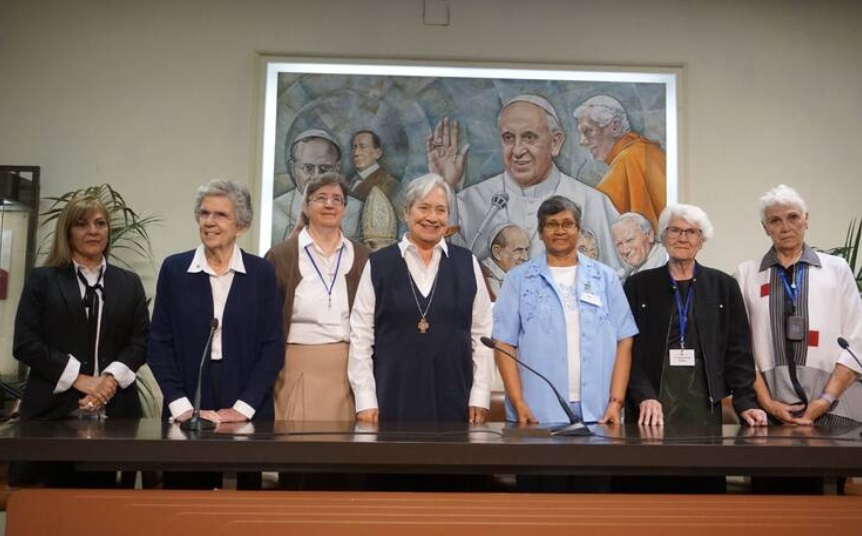What convinced me that we need more women leading at the Vatican
The Synod on Synodality has shown that the Church’s future does not depend solely on priests or bishops but instead, will involve more laypeople — and specifically women — than ever before.
May 19, 2023

Ask me about almost anything related to the Church or politics, and I will err on the side of traditionalism, conservatism...whatever you would like to call it. I have always been a rule follower: I liked wearing uniforms at my all-girls Catholic schools, and I get annoyed when the priest goes off-book saying some of the prayers during Mass. I even enjoy the Latin Mass, at least during the few times I have attended.
So, this realisation, which I had soon after I started working at America, came as a surprise to me: The Church needs (more) women in the hierarchy of the Vatican and its decision-making processes.
Again, I am usually not one to call for big changes or support radical ideas. If the Church has worked this way for 2,000 years, I used to think, who are we to change it now?
But then I ended up working in an organisation that is mostly male, and I realised that for the first time, I was a minority. (America Media has more women and lay staff than it did a decade ago. But there are still more men than women.) Up until a few months ago, every religious space I had ever been in was mostly, or all, female. The religious authorities I knew (outside of my parish priest) were all women, and from what I saw, they never felt the need to have their decisions validated by men.
I went to a small all-girls Catholic school from fourth to eighth grade, then I attended a slightly larger all-girls Catholic high school. My university’s student body skewed towards mostly female (nearly 60 per cent), and the Catholic studies programme I was in had an even more pronounced majority of women. Thus, almost every religious conversation I had, with leaders or peers or family, was initiated by women who were not afraid to speak their minds on Church teaching or anything else.
I never really considered the role of women at the Vatican. In my mind, the authority that Sr Mary Thomas, or my lay teachers, had behind school gates extended to the wider Church. Who would dare to tell Sr Mary Thomas that her opinion is not welcome on any matter of Church governance?
Now, as a woman, I am part of a minority at America, and yet I am working in a religious space that is otherwise familiar to me. I find it strange, though it is probably normal for working women in the rest of the world, to have life experiences that are different than, and perhaps not fully understood by, my male colleagues.
Some examples: I would avoid going to the halal cart outside my apartment alone after about 9.00pm (the man who works there is a little too friendly with the women in my building). I would not think to go on a walk when it’s dark out, nor would I be comfortable sending a friend home late at night by herself. Some of these could be attributed to my self-ascribed status as “mom friend”: the person who acts in a quintessential “mom” way, slightly overprotective and responsible for others. But the fact is that as a woman, I react to personal safety issues in a different way than men do.
What does this have to do with running the Church? Although anyone should be able to take care of vulnerable people, women are simply more sensitive to safety issues. With the sexual abuse crisis ever-present in the minds of the faithful, women, who are often more cognisant of and fight for and alongside those who need protection, can question the status quo and provide input from an outsider’s perspective.
Women like Nathalie Becquart, XMCJ, the first female undersecretary of the Synod of Bishops, have the depth and experience to perform their jobs without being ordained. They are not just a diversity check: Women should be there because of their skills and knowledge. And now that women are allowed to vote in the synod, I have hope that their life experiences will affect the outcomes and documents of the synod.
My experiences with so many women leaders in religious spaces should have made me supportive all along of elevating women in the Vatican. I knew first hand of the strengths that women bring to the table. From leading schools, to being religious education directors and parish managers at so many churches, they have more than enough experience. Women are academic and business leaders, presidents of Catholic universities and many Catholic non-profits. Frankly, they should be in Church leadership already.
The Synod on Synodality has shown that the Church’s future does not depend solely on priests or bishops but instead, will involve more laypeople — and specifically women — than ever before. And that starts with a new attitude, especially from those of us, myself very much included, who sometimes stubbornly resist change. --America







Total Comments:0